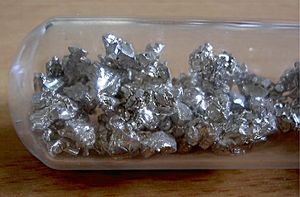Calcium
 Calcium metal under argon. | |||||
| General properties | |||||
|---|---|---|---|---|---|
| Name, symbol | Calcium, Ca | ||||
| Calcium in the periodic table | |||||
| |||||
| Standard atomic weight (Ar) | |||||
| Group, block | , -block | ||||
| Period | period | ||||
| Electron configuration | |||||
| Physical properties | |||||
| Silvery-gray | |||||
| Atomic properties | |||||
Calcium is a chemical element with symbol Ca and atomic number 20. Calcium is a soft gray alkaline earth metal, and is the fifth-most-abundant element by mass in the Earth's crust.
Contents
Properties
Chemical
Calcium is reactive towards air but is often kept in a sealed container as opposed to under oil as its oxidation is not excessively rapid. As pellets or turnings, the metal can be difficult to ignite, more so even than magnesium turnings, but when lit the metal burns in air with a brilliant red light, producing calcium oxide.
Calcium reacts with the usually inert nitrogen, forming calcium nitride. If a container of calcium is left open in a glove box full of nitrogen, the metal will quickly be ruined.
Calcium produces hydrogen on contact with water, at a noticeably slower rater than all the alkali metals when in the same from but powder calcium is much more common than any alkali metal powders, and the increased surface area of the metal produces a rapid reaction. Part of the reason for the slowness of the calcium–water reaction is a result of the metal being partly protected by insoluble white calcium hydroxide. In acids where the calcium salt is soluble, the metal reacts vigorously.
At very high temperatures (usually in an arc furnace) the metal reacts with carbon to produce the useful calcium carbide.
Physical
Calcium is a soft for a metal (though harder than lead, it can be cut with a knife with difficulty). It is a silvery metallic element with a density of 1.55 g/cm3. Calcium has the lowest density of the alkaline earth metals; magnesium (specific gravity 1.74) and beryllium (1.84) are denser though lighter in atomic mass. From strontium onward, the alkali earth metals become denser with increasing atomic mass.
Availability
Calcium can be bought at Gallium Source.
As a reducing agent, it suffers some of the stigma and restrictions sodium does because it can be used in the manufacture of illicit drugs. In Australia, purchasing calcium metal requires an EUD.
Preparation
Preparing calcium metal is not easy or economical for the amateur chemist. It can be extracted by electrolysis from a fused salt like calcium chloride. Once produced, it rapidly forms a gray-white oxide and nitride coating when exposed to air.
Projects
- Producing calcium carbide
- Make calcium nitride
- Extracting lanthanides
Handling
Safety
Compared with other metals, the calcium ion and most calcium compounds have low toxicity. This is not surprising given the very high natural abundance of calcium compounds in the environment and in organisms. Acute calcium poisoning is rare, and difficult to achieve unless calcium compounds are administered intravenously.
Calcium metal is hazardous because of it reacts violently with water and acids. Calcium metal is found in some drain cleaners, where it functions to generate heat and calcium hydroxide that saponifies the fats and liquefies the proteins (e.g., hair) that block drains. When swallowed calcium metal has the same effect on the mouth, esophagus and stomach, and can be fatal.
Storage
Large pieces of calcium metal can be stored in dry air without any severe degradation, as noted by many chemists. Turnings and calcium powder is much more reactive. Like all air-sensitive materials, calcium must be stored in sealed containers or glass ampoules, in an inert atmosphere (such as argon). It can also be stored in mineral oil.
Disposal
Calcium metal can be neutralized by slowly dissolving it in water or simply leaving it in wet air, which turns it into calcium oxide, hydroxide and finally carbonate (or sulfate/nitrate, depending on the quality of air).
As calcium compounds are abundant in the environment and pose no toxicity, no special treatment is required to dispose of them. However it is advised to avoid dumping the poorly soluble ones down the drain as they might build up and clog the pipes.